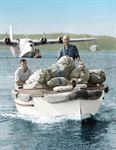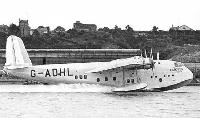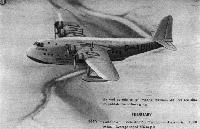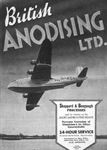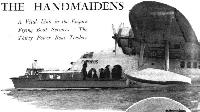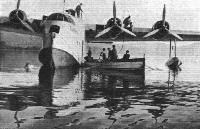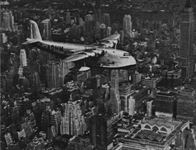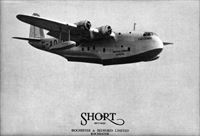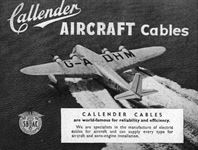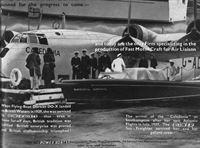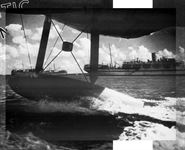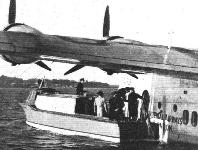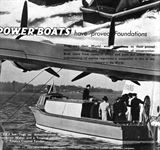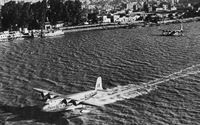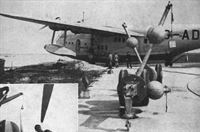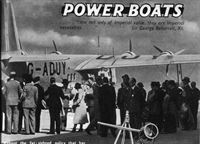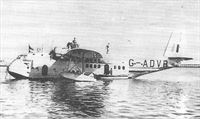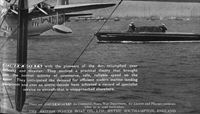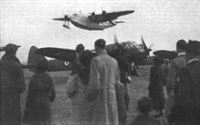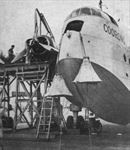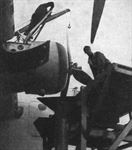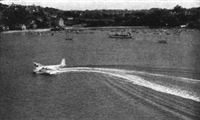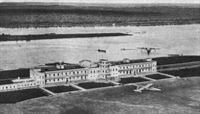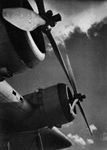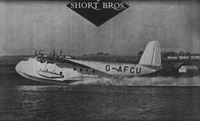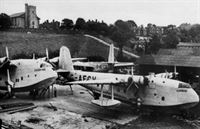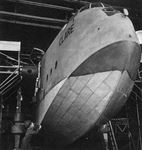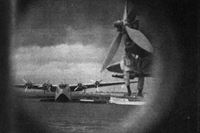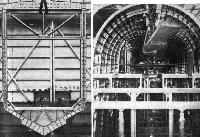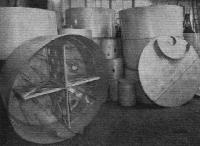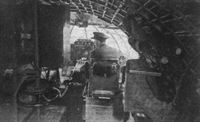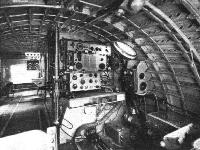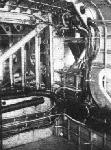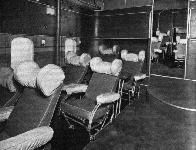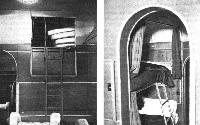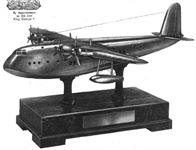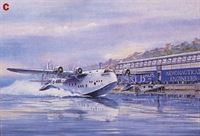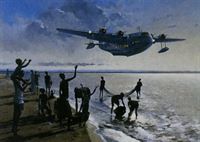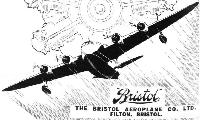
Описание
Страна : Великобритания
Год : 1936
Летающая лодка
Пассажирская/почтовая летающая лодка
Варианты
- Short - Empire / S.23 - 1936 - Великобритания
- Short - Mayo Composite (S.20 Mercury and S.21 Maia) - 1938 - Великобритания
- Short - S.26 G-class - 1939 - Великобритания
Empire / S.23
Short S.23, S.30 и S.33 Empire
По сравнению с большими и громоздкими летающими лодками-бипланами компании "Short Brothers" самолет S.23, появившийся в 1936 году, был совершенно иной конструкции. Он имел четыре двигателя Bristol Pegasus XC мощностью 920 л.с. и конструктивно являлся свободнонесущим цельнометаллическим высокопланом с корпусом обтекаемой формы. Максимальная скорость составляла 322 км/ч, то есть на 42 км/ч больше, чем у стоявшего тогда на вооружении британских ВВС истребителя-биплана Bristol Bulldog.
Характеристики машины казались столь многообещающими, что "Imperial Airways" заказала 28 машин. В то время британское правительство решило, что вся почта первого класса должна доставляться по воздуху, поэтому самолеты, назначенные для почтовых перевозок, получили название Empire или класс "C" ("C" - class). Первый S.23, названный "Canopus", вылетел из Рочестера в июле 1936 года и поступил в эксплуатацию в начале сентября.
Каждый последующий самолет поступал к заказчику с интервалом в две недели. Машины базировались в Хите и использовались на маршрутах "Imperial Airways" для полетов в Австралию, Дурбан, Египет, Малайю, Нью-Йорк, на Бермуды, а также в Восточную и Южную Африку. Базовая вместимость самолетов - 1361 кг почты и 24 пассажира днем или 16 пассажиров ночью, однако увеличение массы почты на 454 кг уменьшало число пассажиров до 17 человек. Трансатлантические полеты без полезной нагрузки, проведенные в 1937 году, показали, что S.23 не был экономически выгодным на всех расстояниях, что в итоге привело к созданию Short-Mayo Composite (описан отдельно).
Кроме того, были проведены испытания по дозаправке в воздухе с использованием самолета Armstrong Whitworth 23 в качестве танкера. Успех этих испытаний привел к заключению контракта с компанией сэра Алана Кобхема, "Flight Refuelling Ltd", которая с помощью четырех самолетов-заправщиков Handley Page Harrow совершила до начала войны 16 успешных трансатлантических перелетов с дозаправкой в воздухе. Еще три S.23 в 1938 году были поставлены "Qantas Empire Airways", которая до того получила три машины от "Imperial Airways". Несмотря на потерю восьми летающих лодок во время аварий за первые два года эксплуатации, S.23 вошли в число одних из наиболее успешных самолетов своем классе в предвоенный период.
Следом за S.23 появились лодки S.30, которые использовались для перевозки почты на трансатлантических маршрутах при обеспечении их заправкой от воздушных танкеров Harrow. Последним вариантом стал S.33 с двигателями Bristol Pegasus XC мощностью 920 л. с. Общее производство самолетов Empire составило 42 машины, включая 31 S.23, девять S.30 и две S.33 (постройка третьей S.33 была отменена).
Несколько S.23 в годы войны были реквизированы для службы в британских ВВС. Из них два были модифицированы в вариант S.23M - с бортовой РЛС для обнаружения надводных целей (ASV) и вооружением, состоявшим из двух турелей по четыре пулемета в каждой и шести глубинных бомб. Войну пережили 13 самолетов семейства Empire, они оснащались на тот момент двигателями Bristol Pegasus мощностью по 1010 л. с. Самолеты были переданы компании "QANTAS" и эксплуатировались до 1947 года.
<...>
ТАКТИКО-ТЕХНИЧЕСКИЕ ХАРАКТЕРИСТИКИ
Short S.23
Тип: пассажирская/почтовая летающая лодка
Силовая установка: четыре звездообразных ПД Bristol Pegasus XC мощностью по 920 л. с. (686 кВт)
Летные характеристики: макс. скорость 322 км/ч; практический потолок 6095 м; дальность 1223 км
Масса: пустого 10 659 кг; максимальная взлетная 18370 кг
Размеры: размах крыла 34,75 м; длина 26,82 м; высота 9,70 м; площадь крыла 139,35 м2
Описание:
- Empire / S.23
- Flight, October 1938
British Commercial Aircraft - Flight, November 1939
Britain's Civil Aircraft
Фотографии
-
Мировая Авиация 234
Регистрационный номер: G-AETY [3] S.23 Clio поступил в эксплуатацию компании "Imperial Airways" в августе 1937 года, а в 1940 году был передан британским ВВС. Самолет разбился в августе 1941 года в районе Лох-Индаал, Шотландия.
-
Aviation Historian 9 / P.Vabre - Lost without trace?
Регистрационный номер: G-AETZ [8] Short S.23 G-AETZ Circe, following the application of grey/green camouflage, fin flashes and its registration to the fuselage above distinctive red, white and blue recognition marking stripes. It was in these colours that Circe was lost on the Tjilatjap-Broome leg of a shuttle flight between the two on February 28, 1942
-
Aviation Historian 5 / P.Vabre - Any port in a storm ... From Qantas Empire Airways
Регистрационный номер: VH-ABD [6], G-AEUH [6] Short S.23 VH-ABD Corio, in the plain markings it wore when first delivered to Qantas Empire Airways in September 1938. After the outbreak of war it would later wear grey/green camouflage and have its British registration, G-AEUH, applied to the fuselage above distinctive red, white and blue recognition marking stripes.
-
Aviation Historian 17 / P.Vabre - Paper Trails in the Sky
Регистрационный номер: G-AEUD [4] In homage to the popular hand-coloured postcards of the era, the author has coloured this 1938 shot of IAL Short S.23 G-AEUD Cordelia at Bima in the Dutch East Indies.
-
Aviation Historian 17 / P.Vabre - Paper Trails in the Sky
Регистрационный номер: VH-ABB [7], G-AFBK [7] An original hand-coloured postcard of the first S.23 to be delivered to QEA, VH-ABB Coolangatta, possibly on its delivery flight, at Townsville, Queensland, in March 1938. The aircraft was delivered with its Australian registration despite not being officially registered there; at this stage it was still technically G-AFBK.
-
Aviation Historian 17 / P.Vabre - Paper Trails in the Sky
The mail is brought ashore from an Empire Air Mail Scheme Short Empire Flying Boat in 1938.
-
Aeroplane Monthly 1989-12 / J.Stroud - Wings of Peace
Регистрационный номер: G-ADHL [58] Флагман компании "Imperial Airways" самолет S.23 "Canopus" вышел на авиалинию Александрия - Бриндизи 31 октября 1936 года. С 5 марта 1937 года летающие лодки класса "C" сменили на маршрутах компании самолеты аэродромного базирования и связали Великобританию с Австралией, Восточной Африкой, Египтом, Малайей и Южной Африкой.
Canopus on the River Medway - its clean lines are clearly shown.
Canopus, G-ADHL, was the prototype Short S.23 Empire Boat and it entered service with Imperial Airways in October 1936.
Lankester Parker made the maiden flight of the first Short S.23 Empire Flying Boat, G-ADHL, on July 3, 1936, and later recalled that working on the company’s big flying-boats - the Empires and the military Sunderland - was the most rewarding experience of his 28-year Short Bros career. -
Flight 1936-08 / Flight Advertisements
Регистрационный номер: G-ADHL [58] FLEDGED: Canopus, the first of the Short Empire flying boats, took the air at Rochester for the first time last week-end, in the hands of Mr. Lankester Parker. This Flight photograph clearly shows the beautifully clean take-off.
-
Aeroplane Monthly 1981-08 / ??? - Boats for the Empire
Регистрационный номер: G-ADHL [58] Another view of Canopus. First of the Empire boats, she made her maiden flight on July 4, 1936, in the hands of J. Lankester Parker. G-ADHL was finally scrapped at Hythe in 1947.
-
Air Enthusiast 1992-12 / P.MacDougall - Medway Dynasty
Регистрационный номер: G-ADHL [58] THE SHORT EMPIRE FLYING-BOAT: fitted with four "Bristol" Pegasus engines. An all-metal high-wing cantilever monoplane flying-boat of high performance, with two-deck, two-step hull, and wing flaps. Provides accommodation for 24 passengers and baggage and 1 1/2 tons of mail. Maximum speed, 200 m.p.h. "Cambria" holds the record for the Trans-Atlantic flight - 10 1/2 hours.
The Empire, or C-Class flying boat, Canopus. The successful prototype of a long-range of aircraft, Canopus entered service with Imperial Airways on October 22, 1936. Again seen on the River Medway, both Rochester Castle and Cathedral can be seen. -
Aviation Historian 37 / R.Pegram - Short's Empire landplane
Регистрационный номер: G-ADHL [58] Arthur Gouge - who, along with his deputy, Claude Lipscomb, was responsible for most of Short’s innovative designs of the 1930s, including the C-class Empire flying-boats. The first of these, G-ADHL Canopus, is seen "on the step” during take-off.
-
Мировая Авиация 102
Регистрационный номер: G-ADHL [58] 3 июля 1936г.: первый полет в Рочестере, графство Кент, выполнила первая летающая лодка "Short Empire" - RMA Canopus (серия "С"), пилот Дж. Ланкестер Паркер. Первый рейс выполнен 30 октября, с началом ее эксплуатации на линии Александрия (Египет) - Бриндизи (Италия).
-
Jane's All the World Aircraft 1938 / 03 - All the world's aeroplanes
Регистрационный номер: G-ADHL [58] The Short "Empire" Commercial Flying-boat (four Bristol "Pegasus X" engines).
-
Flight 1936-09 / Flight
Регистрационный номер: G-ADHL [58] -
Flight 1936-08 / Flight Advertisements
Регистрационный номер: G-ADHL [58] -
Flight 1937-05 / Flight
Регистрационный номер: G-ADHL [58] -
Flight 1936-09 / Flight
Регистрационный номер: G-ADHL [58] -
Flight 1938-01 / Flight Advertisements
Регистрационный номер: G-ADHL [58] -
Flight 1936-10 / Flight
Регистрационный номер: G-ADHL [58] -
Flight 1936-07 / Flight
Регистрационный номер: G-ADHL [58] FOR CIVIL SERVICE: The Short Empire flying boat is powered with four of the new Pegasus Xc civil-rated radials, the official figures for which have just been made known. The international-rated power is 740 h.p. at 3,500 ft., and 910 h.p. is available for take-off with the De Havilland V.P. airscrew. Flaps for controllable cooling are incorporated in the long chord cowlings. This Flight photograph was taken during the second test flight at Rochester.
-
Flight 1936-12 / Flight Advertisements
Регистрационный номер: G-ADHL [58] -
Flight 1936-09 / Flight
Регистрационный номер: G-ADHL [58] -
Flight 1937-03 / Flight Advertisements
Регистрационный номер: G-ADHL [58] -
Aviation Historian 36 / R.Pegram - The golden age?
Регистрационный номер: G-ADHL [58] The first C-Class flying-boat, G-ADHL, named Canopus after the pilot of King Menelaus of Sparta’s ship during the Trojan War, made its first flight on July 3, 1936. As delivered to IAL, Canopus had a cruising speed of 165 m.p.h. (265km/h) at 510 h.p. (of 910 h.p. for take-off) and a range of 760 miles (1,220km) at 165 m.p.h. in still air.
-
Flight 1939-04 / Flight
Регистрационный номер: G-ADHL [58] A new era in commercial flying was opened up with the introduction of the Short Empire flying boat.
-
Flight 1940-02 / Flight Advertisements
Регистрационный номер: G-ADHL [58] -
Flight 1937-11 / Flight
Регистрационный номер: G-ADHL [58] The Short Empire boat is fitted with four Bristol Pegasus Xc engines rated at 740 h.p. each and giving 910 h.p. for take-off.
-
Flight 1936-10 / Flight
Регистрационный номер: G-ADHL [58] HERALDING THE NEW ERA: The first of the Short Empire boats is now in the Mediterranean after being flown across France by capt. Bailey and Major Brackley. This Flight photograph shows Canopus from a somewhat unusual angle; the fully faired rear step and the forward sloping front step are noteworthy features of the hull.
Canopus over the Chatham area on an early test flight. -
Flight 1936-07 / Flight Advertisements
Регистрационный номер: G-ADHL [58] -
Flight 1939-03 / Flight Advertisements
Регистрационный номер: G-ADHL [58] -
Flight 1936-12 / Flight
Регистрационный номер: G-ADHL [58] The Empire boat (four 758/815 h.p. Pegasus X Cs).
-
Flight 1936-11 / Flight
Регистрационный номер: G-ADHL [58] -
Flight 1936-11 / Flight
Регистрационный номер: G-ADHL [58] The first Short Empire boat being refuelled on Lake Bracciana, near Rome.
-
Aeroplane Monthly 1986-08 / E.Kinloch - By Empire boat to India
Регистрационный номер: G-ADHL [58] C-class boat Canopus moored in Alexandria harbour. G-ADHL was scrapped at Hythe in 1947; it had been the first S.23 Empire flying-boat to fly.
-
Aeroplane Monthly 2000-02 / J.Golley - A Clandestine Assignment /Secret ferry flights/
Регистрационный номер: G-ADHL [58] The first of the Short S.23s was G-ADHL Canopus, seen here in the Middle East during the war years. First flown in 1936, it was scrapped at Hythe in 1947.
-
Flight 1937-08 / Flight
Регистрационный номер: G-ADHL [58] ON the river Nile at Malakal, the terminal port for the Imperial Airways flying boats in the Anglo-Egyptian Sudan, large islands of floating papyrus (Cyperus Papyrus) and Um Soof (Vossia Procera) are encountered between May and September. This seasonal scourge is caused by the fact that the floods from the great lakes loosen the roots of the vegetation in the swampy areas farther south. Eventually, large sections break away from the main mass and drift slowly downstream, a menace to flying boats. The photograph shows Canopus safely moored with the floating islands drifting past.
-
Aeroplane Monthly 1990-01 / J.Stroud - Wings of Peace
Регистрационный номер: G-ADHL [58] Canopus, with British Airways and Speedbird on the bows, refuelling at Dar-es-Salaam on the Horseshoe route.
-
Flight 1937-10 / Flight Advertisements
Регистрационный номер: G-ADHL [58] -
Мировая Авиация 215
Регистрационный номер: G-ADHL [58] G-ADHL Canopus - первая летающая лодка компании "Empire", оснащенная моторами Pegasus. Первый полет лодка выполнила в июле 1936 года, в BOAC ее передали в апреле 1940 года.
-
Flight 1936-07 / Flight
Регистрационный номер: G-ADHL [58] -
Aeroplane Monthly 1989-12 / J.Stroud - Wings of Peace
Регистрационный номер: G-ADHL [58] Short Empire ’boat Canopus with de Havilland bracket-type propellers. The unusual fairing at the port inboard engine position suggests a return to Rochester on three engines, with the defective one in the cabin.
Canopus at Rochester in July 1937 after flying from Crete with No 2 engine removed and the nacelle faired over. The previous year it had made the first scheduled flight by an Empire 'boat, from Alexandria to Brindisi. -
Jane's All the World Aircraft 1980 / Encyclopedia of Aviation - Aircraft A-Z - v5
Регистрационный номер: G-ADHL [58] Short Empire Flying Boat Canopus being rolled out.
-
Flight 1936-07 / Flight
Регистрационный номер: G-ADHL [58] -
Flight 1936-07 / Flight
Регистрационный номер: G-ADHL [58] For the Empire air routes: The bird's-eye view gives a good idea of the rounded deck, the wing fillets and the trailing-edge flaps of the first of the new boats. The open door leads to the freight and mail hold.
-
Flight 1936-07 / Flight
Регистрационный номер: G-ADHL [58] One of the hinged platforms used for giving access to the Bristol Pegasus engine.
-
Flight 1936-07 / Flight
Регистрационный номер: G-ADHL [58] -
Aeroplane Monthly 1989-12 / J.Stroud - Wings of Peace
Регистрационный номер: G-ADHL [58] The hull of Canopus at an advanced stage.
-
Air Enthusiast 1992-12 / P.MacDougall - Medway Dynasty
Регистрационный номер: G-ADHL [58], G-ADHM [36] Photo from a pamphlet produced by Shorts to mark the Royal visit to Rochester of 1936. C-Class Canopus (top) is seen nearing completion.
-
Aeroplane Monthly 1989-12 / J.Stroud - Wings of Peace
Регистрационный номер: G-ADHL [58], G-ADHM [36] The main assembly shop at Rochester with Canopus (left) and Caledonia. In the left background another six hulls are under construction. In the foreground are Singapore IIIs.
Другие самолёты на фотографии: Short Singapore III / S.19 - Великобритания - 1934
-
Aeroplane Monthly 1990-01 / J.Stroud - Wings of Peace
Регистрационный номер: G-ADHL [58] Canopus in wartime camouflage at Kisumu.
-
Jane's All the World Aircraft 1938 / 03 - All the world's aeroplanes
Регистрационный номер: G-ADHM [36] The Short "Empire" Commercial Flying-boat. Note the partly-extended Gouge wing-flaps.
-
Flight 1936-10 / Flight Advertisements
Регистрационный номер: G-ADHM [36] -
Aeroplane Monthly 1974-04 / P.Moss - Wings for the Empire (4)
Регистрационный номер: G-ADHM [36] Short S.23 Empire boat, G-ADHM, Caledonia, flying over New York in 1938.
-
Flight 1938-03 / Flight
Регистрационный номер: G-ADHM [36] The Short Empire boat Caledonia over New York after one of her experimental Atlantic trips last year.
-
Aeroplane Monthly 1981-08 / ??? - Boats for the Empire
Регистрационный номер: G-ADHM [36] G-ADHM, aptly positioned with the Empire State building in the background.
-
Flight 1939-02 / Flight Advertisements
Регистрационный номер: G-ADHM [36] -
Aviation Historian 36 / R.Pegram - The golden age?
Регистрационный номер: G-ADHM [36] The second Short S.23 Empire Flying Boat (the official designation had no hyphen in flying-boat), G-ADHM, was given the Imperial Airways “C-Class” name Caledonia, and was built specifically for the company’s Atlantic routes with extra fuel tanks for extended range. It made its first transatlantic flight, from Foynes in Ireland to Botwood, Newfoundland, on July 5, 1937.
-
Flight 1937-08 / Flight Advertisements
Регистрационный номер: G-ADHM [36] -
Flight 1937-07 / Flight Advertisements
Регистрационный номер: G-ADHM [36] "Caledonia" - Imperial Airways Empire Flying Boat (4 Bristol Pegasus Engines) averaged 162 miles per hour between Botwood (Newfoundland) and Foynes (Ireland) on her return flight from New York to Southampton.
-
Aeroplane Monthly 1990-01 / J.Stroud - Wings of Peace
Регистрационный номер: G-ADHM [36] Caledonia after conversion to passenger standard but still carrying the name Imperial Airways.
-
Flight 1937-08 / Flight Advertisements
Регистрационный номер: G-ADHM [36] -
Flight 1939-04 / Flight
Регистрационный номер: G-ADHM [36] SOLITUDE: This photograph was taken by Capt. A. S. Wilcockson, of Imperial Airways, at 11,000ft. over the Atlantic during one of Caledonia's experimental flights along the Foynes - Botwood route in 1937.
-
Flight 1937-07 / Flight Advertisements
Регистрационный номер: G-ADHM [36] Imperial Airways Flying Boat "CALEDONIA" (manufactured by Short Bros. (Rochester & Bedford) Ltd. and fitted with Bristol "Pegasus" Engines)
-
Aeroplane Monthly 1989-12 / J.Stroud - Wings of Peace
Регистрационный номер: G-ADHM [36] Caledonia flying with flaps lowered.
-
Flight 1937-07 / Flight
Регистрационный номер: G-ADHM [36] A remarkable photograph of Caledonia taken just as she was about to "unstick" at the start of a radio test flight from Southampton Water shortly before leaving for Foynes, and, ultimately Newfoundland
On July 6th the Imperial Airways Empire flying boat "CALEDONIA" completed the first East to West commercial survey flight across the North Atlantic. -
Flight 1938-10 / Flight Advertisements
Регистрационный номер: G-ADHM [36] -
Flight 1938-01 / Flight
Регистрационный номер: G-ADHM [36] Two of the boats which made history last year - Caledonia and Clipper III - being hauled on to the slipway at Hythe (left). The former was commanded by Capt. Wilcockson and the latter by Capt. Gray on all the Atlantic trips.
-
Flight 1936-09 / Flight
Регистрационный номер: G-ADHM [36] Caledonia, the second Empire boat, and a Singapore.
-
Aeroplane Monthly 1989-12 / J.Stroud - Wings of Peace
Регистрационный номер: G-ADHM [36] Caledonia on one of the Rochester slipways. One of two long-range S.23s for North Atlantic survey operations, Caledonia first flew on September 11,1936.
-
Flight 1937-09 / Flight Advertisements
Регистрационный номер: G-ADHM [36] -
Flight 1937-07 / Flight Advertisements
Регистрационный номер: G-ADHM [36] -
Jane's All the World Aircraft 1938 / 03 - All the world's aeroplanes
Регистрационный номер: G-ADHM [36] The Short "Empire" Flying-boat "Caledonia" which was used, in company with the sister-ship "Cambria," on the experimental trans-Atlantic survey during 1937.
-
Flight 1937-07 / Flight
Регистрационный номер: G-ADHM [36] -
Flight 1937-07 / Flight Advertisements
Регистрационный номер: G-ADHM [36] The Imperial Airways flying-boat Caledonia, like all the other craft in its class designed to operate on the great trunk routes of the British Empire, is equipped with controllable-pitch airscrews manufactured in England by the de Havilland Aircraft Co., Ltd.
-
Flight 1936-12 / Flight
Регистрационный номер: G-ADHM [36] The long-range Short boat, Caledonia, moored off Hythe, Southampton. After the necessary fuel consumption and other tests have been carried out this boat will be flown to Foynes for a series of experimental crossings to Botwood, Newfoundland.
-
Aeroplane Monthly 1974-04 / P.Moss - Wings for the Empire (4)
Регистрационный номер: G-ADHM [36] Caledonia again, this time at Foynes at the mouth of the Shannon during proving flights in July 1937.
-
Flight 1937-10 / Flight
Регистрационный номер: G-ADHM [36] ATLANTIC SURVEY: Caledonia taxies to her moorings at Horta, Azores, after her recent survey trip in command of Captain Powell.
-
Flight 1937-07 / Flight
Регистрационный номер: G-ADHM [36] Another view of Caledonia, seen in July 1937 at Foynes.
-
Flight 1938-04 / Flight Advertisements
Регистрационный номер: G-ADHM [36] -
Flight 1938-09 / Flight Advertisements
Регистрационный номер: G-ADHM [36] -
Flight 1937-07 / Flight Advertisements
Регистрационный номер: G-ADHM [36] -
Aeroplane Monthly 1981-02 / Radlett /Gone but not forgotten/ (9)
Регистрационный номер: G-ADHM [36] The photograph was taken from inside the cabin of the Short S.23 Empire Flying Boat G-ADHM, Caledonia in June 1937, just prior to its first transatlantic crossing made on July 5.
-
Flight 1937-02 / Flight
Регистрационный номер: G-ADUT [9], A18-10 [9] CENTAURUS SETS OUT: Loading up at Hythe, Southampton, for the inaugural Empire service. Passengers are boarding the machine from one of Imperial Airways' new 37ft. 6in. tenders, supplied by the British Power Boat Company The photograph, incidentally, gives an interesting close-up of the flying boat's wing, with its flap.
-
Flight 1938-09 / Flight Advertisements
Регистрационный номер: G-ADUT [9], A18-10 [9] -
Flight 1937-01 / Flight
Регистрационный номер: G-ADUT [9], A18-10 [9] The most advanced civil aircraft yet in service: the peerless Short Empire flying boat with four Bristol Pegasus XC engines.
Centaurus, G-ADUT, was the third Empire Boat and ended its days Australian Air Force. -
Aviation Historian 5 / P.Vabre - Any port in a storm ... From Qantas Empire Airways
Регистрационный номер: G-ADUT [9], A18-10 [9] A glorious photograph of Short S.23 Empire Flying Boat G-ADUT Centaurus arriving at Wellington Harbour, New Zealand, on New Year’s Eve, 1937.
-
Air Pictorial 1969-06 / N.Parnell, C.Lynch - History of the R.A.A.F. (6)
Регистрационный номер: G-ADUT [9], A18-10 [9] Another Empire boat, G-ADUT "Centaurus" (c/n. S.811) was impressed as A18-10 on 21 st September 1939, and also issued to No. 11 Squadron. After a similar history to A18-11's, it was destroyed by enemy action at Broome, Western Australia, on 3rd March 1942
-
Air Enthusiast 1998-05 / E.Davies - Pioneering the Pacific
Регистрационный номер: G-ADUT [9], A18-10 [9] Гидропланы S-42 и S.23 в порту Окленда. 1937 г.
S-42-B NC16734 and Imperial Airways C-Class ‘Centaurus’ at Auckland, December 1937.Другие самолёты на фотографии: Sikorsky S-42 Clipper - США - 1934
-
Jane's All the World Aircraft 1938 / 01 - The progress of the world in civil aviation during the year 1937-38
Регистрационный номер: G-ADUT [9], A18-10 [9] THE SOUTHERNMOST JUNCTION. - The "Centaurus" of Imperial Airways (Capt. Burgess) and the "Samoan Clipper" of Pan American Airways (Capt. Mustek) in Waitimata Harbour, Auckland, New Zealand, in January, 1938. The latter was lost with all hands near Pago Pago soon after this meeting.
Другие самолёты на фотографии: Sikorsky S-42 Clipper - США - 1934
-
Aeroplane Monthly 1981-08 / ??? - Boats for the Empire
Регистрационный номер: G-ADUT [9], A18-10 [9] Centaurus being towed to her moorings in Rose Bay, Sydney, 1939.
-
Flight 1936-11 / Flight
Регистрационный номер: G-ADUT [9], A18-10 [9] CLEANLINESS: The entire lack of avoidable excrescences is obvious in this front view of the Short Centaurus, third of the Empire flying boats, some flying impressions of which appear on the following page. Centaurus will probably be on her way to the Mediterranean by the time this issue appears.
-
Flight 1936-12 / Flight
Регистрационный номер: G-ADUU [13] BERMUDA RIGGED. The hull of Cavalier, the Short Empire flying boat which will operate in conjunction with a machine of Pan-American Airways on the Bermuda - New York service, being hoisted, in what is said to be the world's largest packing case, aboard the S.S. Loch Katrine. The case follows the lines of the hull remarkably closely; if the bottom corners were "gouged" out the resemblance would be even more striking.
-
Air Enthusiast 2001-01 / T.Singfield - The Free Air of Heaven
Регистрационный номер: G-ADUU [13] New Year 1937, and the scene at the Naval Dockyard on Ireland Island shows 'Cavalier' out of its crate and with its special outrigger floats attached ready to be lifted into the water for the tow to Darrell's Island.
-
Flight 1937-02 / Flight
Регистрационный номер: G-ADUU [13] IN BERMUDA: This somewhat unusual picture shows how Cavalier's hull was towed from the naval dockyard to the Darren's Island base, where the machine is being assembled. The floats on either side are, of course, quite temporary affairs.
-
Flight 1937-03 / Flight
Регистрационный номер: G-ADUU [13] SUNSHINE SOMEWHERE: A heart-warming picture, in these chilly British March days, ot the Short Empire Boat Cavalier at the Bermuda Air Base for her experimental Bermuda to New York flights. Leaning from the cockpit is Capt. Armstrong, the commander, and in uniform is First Officer Richardson (second pilot); in mufti on top of the machine is Mr Bell. Short Bros., and Mr. Hayuen, of the A.I.D., is behind the flag mast.
Cavalier, G-ADUU, on the slipway at Imperial Airways' Bermuda base in 1938. -
Flight 1938-01 / Flight Advertisements
Регистрационный номер: G-ADUU [13] One of the four "Bristol" Pegasus Xc engines fitted in "Cavalier".
-
Air Enthusiast 2001-01 / T.Singfield - The Free Air of Heaven
Регистрационный номер: G-ADUU [13] Luggage is loaded aboard Short C-Class 'Cavalier' by a small team of Imperial Airways employees on Darrell's Island, prior to departure to Baltimore
-
Flight 1937-12 / Flight
Регистрационный номер: G-ADUU [13] BALTIMORE INAUGURATION: Some of the crowd of 30,000 lining the banks of the Patapsco river to watch the recent inauguration of the new Baltimore Airport for landplanes and marine aircraft. It replaces New York as the terminus of the Bermuda route; the Sikorsky S.42b Bermuda Clipper is seen being brought to the landing stage, and in the background is the Short Empire boat Cavalier.
Другие самолёты на фотографии: Sikorsky S-42 Clipper - США - 1934
-
Jane's All the World Aircraft 1938 / 01 - The progress of the world in civil aviation during the year 1937-38
Регистрационный номер: G-ADUU [13] BALTIMORE SEAPLANE STATION. - The populace turns out to see the "Cavalier," an Empire Boat of Imperial Airways, from Bermuda and a Sikorski "Clipper" of Pan American Airways. Baltimore is the American terminus during the Winter of the Bermuda-U.S.A. airline. In the Summer Port Washington, Long Island, New York, is used.
Другие самолёты на фотографии: Sikorsky S-42 Clipper - США - 1934
-
Aeroplane Monthly 1989-12 / J.Stroud - Wings of Peace
Регистрационный номер: G-ADUU [13] G-ADUU Cavalier, one of the first production batch of S.23s,at Darrell's Island, Bermuda.
-
Air Enthusiast 2000-11 / G.Warner - Founding Fathers (2)
Регистрационный номер: G-ADUU [13] Ordered straight of the drawing board, the Short 'C'-Class - G-ADUU 'Cavalier'.
-
Flight 1938-04 / Flight
Регистрационный номер: G-ADUU [13] The Short Empire boat, demonstrating the use of the Gouge flaps which contribute in no small measure to its excellent performance.
-
Flight 1937-01 / Flight
Регистрационный номер: G-ADUU [13] Short Empire boat (four 740 h.p. Bristol Pegasus XCs)
-
Flight 1937-12 / Flight
Регистрационный номер: G-ADUU [13] ATLANTIC TERMINUS: Cavalier flies over the new land-sea air base at Baltimore. The seaplane jetty is in the lower right-hand corner of the picture with the airport site behind it.
-
Flight 1937-02 / Flight
Регистрационный номер: G-ADUV [14] LONG-RANGE EXPERIMENT: Following Caledonia's non-stop flight from Southampton to Alexandria, the second long-range Short boat, Cambria, made a circuit of Britain last Sunday. This photograph shows Cambria being moored off Hythe at the end of the flight, with the liner Westernland in the background.
-
Air Pictorial 1977-12 / J.Hunt - Aviation in the Sudan - before independence
Регистрационный номер: G-ADUV [14] Seen at Rochester, Kent, where it was built, Short C-class "Empire" flying-boat G-ADUV "Cambria" made a proving flight down the African route in May 1937. Imperial Airways services with the type started the next month
-
Aeroplane Monthly 2000-02 / J.Golley - A Clandestine Assignment /Secret ferry flights/
Регистрационный номер: G-ADUV [14] After their trans-South Atlantic adventures the RAF navigators were flown from Lagos to Freetown in a BOAC Short S.23 C-Class Empire Flying Boat. Here, G-ADUV Cambria, with its registration underlined with red, white and blue stripes, takes off from Rod el-Faraq on the River Nile.
-
Aeroplane Monthly 1990-01 / J.Stroud - Wings of Peace
Регистрационный номер: G-ADUV [14] Cambria after conversion to passenger standard, taking off from the Nile. It has the Speedbird on the bows and wartime identity markings.
-
Flight 1937-09 / Flight Advertisements
Регистрационный номер: G-ADUV [14] -
Flight 1937-08 / Flight Advertisements
Регистрационный номер: G-ADUV [14] Caledonia and Cambria, the two Imperial Airways Empire Flying Boats, powered by 4 Bristol Pegasus engines have now both made the double crossing of the Atlantic to scheduled time.
-
Aeroplane Monthly 1990-04 / R.Moulton - Last 'boat to Durban
Регистрационный номер: G-ADUV [14] Cambria with a jury rig supporting the port outer Pegasus and a movable work platform for maintenance access.
-
Aeroplane Monthly 1990-04 / R.Moulton - Last 'boat to Durban
Регистрационный номер: G-ADUV [14] Leading edge platforms lowered on the starboard side of Cambria. Note the long hatch to the flight deck.
-
Авиация и Космонавтика 2020-07 / Ю.Кузьмин - Дозаправка в воздухе: от первых опытов к первому в мире беспилотному заправщику
Регистрационный номер: G-ADUV [14] Заправщик A.W.23 и летающая лодка S.23 Empire над Атлантикой перед дозаправкой
Другие самолёты на фотографии: Armstrong Whitworth A.W.23 - Великобритания - 1935
-
Flight 1939-01 / Flight
Регистрационный номер: G-ADUV [14] REFUELLING EXPERIMENT: For some time experiments have been going on at Ford aerodrome under Sir Alan Cobham's direction. In this photograph the Short Cambria is being refuelled by the A.W.23 used for the work.
Refuelling will be the important feature of this year's Atlantic experiments as far as this country is concerned. Cambria is shown above taking on fuel (or pretending to, for the benefit of the photographer) from the A.W.XXIII, which has been used for experiments at Ford aerodrome.
The sole AW23, K3585, makes a refuelling contact with Short S.23 G-ADUV Cambria.Другие самолёты на фотографии: Armstrong Whitworth A.W.23 - Великобритания - 1935
-
Aviation Historian 30 / P.Vabre - From Flying to Spying (1)
Регистрационный номер: G-ADUV [14] Taken by DCA Radio Inspector Ivan Hodder, this photograph shows Cambria arriving at Dili on January 21, 1941, on the inaugural scheduled eastbound service, NE51.
-
Flight 1937-03 / Flight
Регистрационный номер: G-ADUV [14] SPLICING THE MAINBRACE: One of the new Shell refuelling tenders ministering to the Empire boat Cambria during a demonstration at Southampton last week These tenders carry 2,500 gallons of spirit and 200 of oil, and deliver the former at 120 gall./min. Twenty-one are under construction, by Dunstans, of Doncaster, Rowhedge Ironworks, of Colchester, and Thornycrofts. Others are being built for use along the routes.
-
Aeroplane Monthly 1974-04 / P.Moss - Wings for the Empire (4)
Регистрационный номер: G-ADUV [14] Mail being loaded aboard Cambria at Southampton in 1937. This aircraft was later used for in-flight refuelling experiments.
-
Flight 1939-01 / Flight
Регистрационный номер: G-ADUV [14] CAMBRIA, at Southampton, provides a frame for the Canadian Pacific liner Montcalm
-
Aviation Historian 24 / R.Pegram - Imperial Airways. The 1930s: a cause for concern?
Регистрационный номер: G-ADUW [7] Pre-war shot of Short S.23 Empire flying-boat G-ADUW Castor, which flew the first leg of the journey, with an Imperial Airways boarding launch alongside.
Short S.23 C-Class Empire Flying Boat G-ADUW Castor flies the flag for Imperial after its introduction into service in January 1937. The following month Imperial’s C-Class 'boats began regular services on the Empire routes from Hythe, the S.23s representing the pinnacle of intercontinental flight at the time -
Aviation Historian 30 / P.Vabre - From Flying to Spying (1)
Регистрационный номер: G-ADUW [7] Short S.23 Empire Flying Boat G-ADUW Castor made a diversion on westbound Horseshoe Route service WS47 on December 29, 1940, to bring a party of Australian Department of Civil Aviation (DCA) officials to Dili. As well as negotiating an air service to Portuguese Timor, the party also had a secondary intelligence role, to gather information about the colony and the Japanese presence there.
-
Flight 1938-05 / Flight
Регистрационный номер: G-ADUW [7] Castor moored in the Solent shortly before the war.
-
Flight 1938-05 / Flight
Регистрационный номер: G-ADUW [7] Castor on dry land. The surrealistic piece of mechanism is the beaching gear, with its buoys.
-
Aeroplane Monthly 1981-08 / ??? - Boats for the Empire
Регистрационный номер: G-ADUW [7] Castor, G-ADUW, seen on the Hythe slipway in 1938.
-
Aeroplane Monthly 1990-04 / R.Moulton - Last 'boat to Durban
Регистрационный номер: G-ADUW [7] Castor, one of the early S.23 'boats, being overhauled with Champion.
-
Aviation Historian 31 / P.Vabre - From Flying to Spying (2)
Регистрационный номер: G-ADUW [7] In the 1940s Dili was a small and rather down-at-heel town. The largest building was the cathedral, visible in the centre of the picture directly below the “step” of the flying-boat’s float. DCA airport engineer Bill Bradfield took this photo as Empire Flying Boat Castor arrived over Dili harbour on December 29, 1940.
-
Aeroplane Monthly 1976-03 / N.Stapleton - Marine airport officer
Регистрационный номер: G-ADUX [3] Short S.23 Empire Boat Cassiopeia on the tarmac in front of the hangar at Hythe.
-
Aeroplane Monthly 1976-03 / N.Stapleton - Marine airport officer
Регистрационный номер: G-ADUX [3] This view from the Airport Officer's office shows Cassiopeia nearest.
-
Aviation Historian 36 / R.Pegram - The golden age?
Регистрационный номер: G-ADUX [3] At most stops along Imperial’s routes customers were transferred to and from the aircraft by launch, as seen here as passengers board G-ADUX, named Cassiopeia after the mother of Andromeda in Greek mythology. It was only in April 1938 that a dedicated mooring jetty was constructed at Imperial’s base at Southampton Docks.
-
Aeroplane Monthly 1989-12 / J.Stroud - Wings of Peace
Регистрационный номер: G-ADUY [4] Capella on the Nile at Cairo.
-
Flight 1938-11 / Flight Advertisements
Регистрационный номер: G-ADUY [4]
-
Flight 1937-09 / Flight
Регистрационный номер: G-ADUZ CYGNUS plays the lead - an attractive "still" from Paul Rotha's documentary film, The Future's in the Air, now being completed by the Strand Film Co. The picture deals with our Empire airways.
-
Air Enthusiast 1994-09 / A.Wood - Airline at War
Регистрационный номер: G-ADVB [15] Short S.23 G-ADVB Corsair of BOAC, 1943/1944.
-
Aeroplane Monthly 1990-01 / J.Stroud - Wings of Peace
Регистрационный номер: G-ADVB [15] Corsair at Cairo. British Overseas Airways and the Speedbird are painted on the bows.
-
Aeroplane Monthly 1981-10 / J.Kells - C Boat Saga
Регистрационный номер: G-ADVB [15] Imperial Airways' Short S.23 Empire Boat G-ADVB being hauled up the Hythe slipway.
-
Aeroplane Monthly 1991-04 / Personal album. Civil
Регистрационный номер: G-ADVB [15] Short S.23 G-ADVB Corsair where she finished up in thick mud on the River Dungu, about 150 miles south-west of Juba, following a first unsuccessful attempt to fly it out on July 13, 1939. The attempt was made by Capt Alcock, brother of Atlantic flyer John. Corsair went into service with Imperial Airways in April 1937.
-
Aeroplane Monthly 1991-04 / Personal album. Civil
Регистрационный номер: G-ADVB [15] Work starts on removing the Bristol Pegasus engines and flaps in order to lighten Corsair as much as possible before raising the hull for repair work.
-
Aeroplane Monthly 1991-04 / Personal album. Civil
Регистрационный номер: G-ADVB [15] Another view of Corsair before work began on stripping it for raising from the river. The hull had been badly damaged a second time following the abortive first attempt to fly it out.
-
Aeroplane Monthly 1991-04 / Personal album. Civil
Регистрационный номер: G-ADVB [15] The engines were towed up river on this raft. The workforce was native labour from a convict settlement, the men working at the rate of 2d (0-8p) per day; one of their tasks was building a barrage to raise the river level so that Corsair could take off safely.
-
Aeroplane Monthly 1991-04 / Personal album. Civil
Регистрационный номер: G-ADVB [15] Corsair was supported by means of staging on the starboard side and with a raft on the other. Work begins on raising the 'boat by means of a pump from inside and jacks on either side. The four Pegasus engines have been removed to lighten the aircraft as much as possible during lifting.
-
Flight 1940-01 / Flight
Регистрационный номер: G-ADVB [15] (1) This is where the pilot held the sinking Corsair against the bank with the engines. (2) The damaged chine, caused by striking a submerged rock. (3) Building the barrage: showing the mat of rushes and the box frames to be filled with stone. (4) Jacked up for temporary patching prior to beaching.
-
Aeroplane Monthly 1991-04 / Personal album. Civil
Регистрационный номер: G-ADVB [15] The first engine runs, viewed from Corsair’s cockpit, on November 9, 1939. On November 18 all the engines were run and the 'boat was moved forward several feet.
-
Aeroplane Monthly 1991-04 / Personal album. Civil
Регистрационный номер: G-ADVB [15] Ready to be flown off by Capt Kelly Rogers. Mr Cowling, who took these photographs, last saw Corsair at Feradje on December 23 - his last job on the aircraft was to remove the badly corroded throttle receivers from two of the engines. Capt Kelly Rogers flew Corsair away on January 6, 1940.
-
Aeroplane Monthly 1991-04 / Personal album. Civil
Регистрационный номер: G-ADVB [15] Corsair is repaired and almost ready to be flown out. Seen in jubilant mood on the river bank are, from left to right. Radio Officer Wytcherley (known to the natives as “Mokoto”, The King), Roy Sisson, later Sir Roy, electrician John Love and Ernie Arroll, who was engineer in charge on site.
-
Flight 1937-07 / Flight
Регистрационный номер: G-ADVC [2] The Sikorsky is seen from under the wing of an Empire flying boat, Courtier.
Другие самолёты на фотографии: Sikorsky S-42 Clipper - США - 1934
-
Flight 1937-12 / Flight
Регистрационный номер: G-ADVC [2] Другие самолёты на фотографии: Sikorsky S-42 Clipper - США - 1934
-
Flight 1938-12 / Flight Advertisements
Регистрационный номер: G-ADVD [3] -
Flight 1938-08 / Flight Advertisements
Регистрационный номер: G-ADVD [3] -
Aeroplane Monthly 1981-10 / J.Kells - C Boat Saga
Регистрационный номер: G-ADVD [3] AFRICAN SCENE: One of Imperials’ flying boats moored on the Nile beside the passengers’rest “house” - the good ship Mayflower.
Empire Boat G-ADVD, Challenger, on the Nile in 1939 beside the passengers’ rest house, the good ship Mayflower.
-
Jane's All the World Aircraft 1938 / 01 - The progress of the world in civil aviation during the year 1937-38
Регистрационный номер: G-AETV [5], VH-ABG [5] WINGS ON THE WATER AT MARSEILLE. - The Imperial Airways "Empire" boat, "Coriolanus," on the Etang de Berre at Marignane. This was on the mid-day halt between Southampton and Rome, and the passengers are in the airport restaurant. Behind is the Loire Long-range Commercial Flying-boat (four 720 h.p. Hispano-Suiza motors) the "Bretagne".
Другие самолёты на фотографии: Loire Loire 102 Bretagne - Франция - 1936
-
Flight 1939-05 / Flight Advertisements
Регистрационный номер: G-AETV [5], VH-ABG [5] -
Aeroplane Monthly 1986-08 / E.Kinloch - By Empire boat to India
Регистрационный номер: G-AETV [5], VH-ABG [5] BASRAH'S NEW AIRPORT (MARGIL). - The combined marine and land Airport at Basra, Iraq, the water-front on the River Tigris, with S.23 G-AETV Coriolanus moored outside the terminal building.
-
Aviation Historian 9 / P.Vabre - Lost without trace?
Регистрационный номер: G-AETV [5], VH-ABG [5] A rare photograph of G-AETV Coriolanus being refuelled from the demasted pearling lugger Gerardo at Broome during the fortnight of shuttle services to Tjilatjap. Trapped in Australia, Coriolanus was transferred to the Australian register as VH-ABG in August 1942, and became the only Empire flying-boat to survive the war in Australia. It was finally retired in January 1948, the last airworthy Empire Flying Boat anywhere in the world.
-
Flight 1937-07 / Flight
Регистрационный номер: G-AETW [6] INCIDENTS at Hatfield last Tuesday: Mr. J. Lankester Parker is demonstrating the Short Empire boat Calpurnia.
-
Aviation Historian 36 / R.Pegram - The golden age?
Регистрационный номер: G-AETW [6] The career of G-AETW Calpurnia was comparatively short; having made its first flight at the end of June 1937, it crashed in Lake Habbaniyah during a sandstorm at night on November 27, 1938, Capt Attwood, First Officer Spottiswoode and two passengers being killed. The all-important Christmas mail was rescued, however.
-
Flight 1938-10 / Flight
Регистрационный номер: G-AETW [6] Too well known even to require naming, an example of the Short Empire boat is shown here with the Gouge flaps partly depressed. The first of the eight new high-payload versions of the same machine should be coming out of the Rochester works very shortly. A modified version of the Empire boat forms the lower component of the Short-Mayo Composite Aircraft.
-
Flight 1938-05 / Flight
Регистрационный номер: G-AETW [6] Somebody wanted to know if Calpurnia had been well greased underneath - just in case.
-
Air-Britain Archive 1983-04
Регистрационный номер: G-AETW [6] Listed in the above extract are twelve of the second batch of fourteen Empire Flying Boats for Imperial Airways. Missing are G-AETW "Calpurnia" which crashed 27.11.38 at Lake Habbaniyah and G-AEUG, already VH-ABC with Qantas.
-
Aeroplane Monthly 1976-03 / N.Stapleton - Marine airport officer
Регистрационный номер: G-AETW [6] Empire Boat Calpurnia secured to a mooring buoy. This aircraft crashed in Iraq in November 1938, the year these photographs were taken.
-
Aeroplane Monthly 1976-03 / N.Stapleton - Marine airport officer
Регистрационный номер: G-AETX [3] Short S.23 Empire Boat Ceres, taxiing out from Hythe before takeoff.
-
Air Enthusiast 1996-09 / H.Yea - The 'Empire' Strikes Back!
Регистрационный номер: G-AETX [3] S.23 G-AETX ‘Ceres’, wrecked December 1,1942.
-
Aviation Historian 36 / R.Pegram - The golden age?
Регистрационный номер: G-AETX [3] Named Ceres after the Roman goddess of agriculture, S.23 G-AETX made its first flight in July 1937, and was used to survey the IAL route from Alexandria in Egypt to Karachi in India (now Pakistan) via Habbaniyah in Iraq and Sharjah in the Persian Gulf two months later. It was destroyed by an explosion while moored at Durban in December 1942.
-
Flight 1938-03 / Flight Advertisements
Регистрационный номер: G-AETY [3] -
Мировая Авиация 215
Регистрационный номер: G-AETY [3] G-AETY Clio, одна из летающих лодок S.23, переданных Береговому командованию ВВС Великобритании. С установленным оборонительным вооружением и РЛС лодка состояла на вооружении 201-й эскадрильи, пока не разбилась в 1941 году.
-
Aviation Historian 9 / P.Vabre - Lost without trace?
Регистрационный номер: G-AETZ [8] Short S.23 Empire Flying Boat G-AETZ (c/n S.842), named Circe, has its port outer Bristol Pegasus engine run up at Imperial Airways’ maintenance base at Hythe before the war. The aircraft made its first flight on August 16, 1937, and operated its first commercial service the following month. By November 1941 it had been put into camouflage.
-
Aviation Historian 9 / P.Vabre - Lost without trace?
Регистрационный номер: G-AETZ [8] Photographs of Circe are comparatively rare; this example, taken at an unidentified location before the flying-boat’s adoption of camouflage, shows a mooring rope being thrown to the Radio Officer, who is standing in the bow mooring hatch. The aircraft’s captain would supervise the mooring process from the cockpit above.
-
Flight 1938-04 / Flight
Регистрационный номер: G-AETZ [8] Empire debarkation: The new pontoon gangway at Berth 10, New Dock, Southampton.
Passengers coming ashore at the Imperial Airways terminal at Southampton in April 1938. -
Aviation Historian 9 / P.Vabre - Lost without trace?
Регистрационный номер: G-AETZ [8] NOT RIVALS YET: The Short Circe taxying past the new liner Capetown Castle, which will shortly make her maiden voyage. Five days against fourteen to the Cape!
Another image of Circe in happier times - G-AETZ taxies away from Southampton’s Berth 108 at the start of a pre-war Empire Air Mail Scheme voyage to Australia or South Africa. Behind, the Union-Castle Line’s RMMV Capetown Castle also readies for another, much slower, journey to South Africa. -
Aeroplane Monthly 1981-08 / ??? - Boats for the Empire
Регистрационный номер: G-AETZ [8] Circe, G-AETZ, with the liner Cape Town Castle giving scale to to the picture.
-
Aviation Historian 9 / P.Vabre - Lost without trace?
Регистрационный номер: G-AETZ [8] A poor-quality but rare photograph of Circe at the Qantas flying-boat base at Groote Eylandt in the Gulf of Carpentaria, taken in 1940 during the Horseshoe Route period. Control launch C.A.1 is moored alongside the door, with Shell refuelling vessel Renown beside the flying-boat’s starboard bow.
-
Aviation Historian 9 / P.Vabre - Lost without trace?
Регистрационный номер: G-AETZ [8] In camouflage with fin flashes and red, white and blue identification stripes beneath the registration, Circe awaits its next voyage at the Qantas terminal at Rose Bay, Sydney, in November 1941. Unarmed and carrying civilians, the Empires were still targets for Japanese fighters, as the loss of Corio on January 30, 1942, proved.
-
Aviation Historian 5 / P.Vabre - Any port in a storm ... From Qantas Empire Airways
Регистрационный номер: G-AEUA [7], VH-ABD [6], A18-11 [7], G-AEUH [6] Short S.23 G-AEUA Calypso (later the RAAF’s A18-11), and Corio at 108 Berth at Southampton Docks in 1938. Both aircraft have been docked in Braby Pontoons, which allowed the passengers to walk to their aircraft and made freight-loading a much easier process than back in Australia, where the facilities were somewhat cruder.
-
Flight 1938-09 / Flight
Регистрационный номер: G-AEUA [7], A18-11 [7] Tiberias, on the Sea of Galilee, seemingly quiet, but a centre of the present troubles.
-
Air Pictorial 1977-01 / J.Stroud - Looking Back at 'Boats
Регистрационный номер: G-AEUA [7], VH-ABA [3], A18-11 [7], G-AFBJ [3] Short S.23 C-class Empire flying-boats VH-ABA "Carpentaria" (ex G-AFBJ, transferred to Qantas in November 1937) and G-AEUA "Calypso” off Hythe, 21st June 1938
-
Air-Britain Archive 1980-04
Регистрационный номер: G-AEUA [7], A18-11 [7] Short S.23 Empire Flying Boat G-AEUA is seen here at Rochester. Named "Calypso" it entered service on 4.9.37 and was transferred to Qantas two years later. It became A18-11 with the RAAF and eventually crashed in New Guinea 8.8.42.
-
Aeroplane Monthly 1974-04 / P.Moss - Wings for the Empire (4)
Регистрационный номер: G-AEUA [7], A18-11 [7] Short S.23 Empire boat, G-AEUA, Calypso, before she was transferred to QEA.
-
Flight 1938-02 / Flight
Регистрационный номер: G-AEUA [7], A18-11 [7] -
Air Pictorial 1969-06 / N.Parnell, C.Lynch - History of the R.A.A.F. (6)
Регистрационный номер: A18-11 [7], G-AEUA [7] Short C-Class flying-boat A18-11 (c/n. S.843, ex G-AEUA "Calypso"). Impressed by the R.A.A.F. on 21 st September 1939, it served with No. 11 Squadron until 18th November 1941 when it was transferred to No. 20 Squadron. Later, on 12th February 1942, it was taken over by No. 33 Squadron, and on 8th August 1942 crashed into the Torres Strait off the Fly River, Papua
-
Flight 1937-10 / Flight Advertisements
Регистрационный номер: G-AEUC [2] -
Flight 1939-01 / Flight Advertisements
Регистрационный номер: G-AEUC [2]
-
Flight 1937-12 / Flight
Регистрационный номер: G-AEUD [4] FAR EASTERN SURVEY: The Short Cordelia, which has recently returned from a survey of the new boat route as far as Singapore, swings at her moorings in Kallang Basin. Singapore airport is in the background and the personnel to be seen are, from the left, First Officer Stone, Capt. Egglesfield and Radio Operator Coster.
The pilots of Cordelia, G-AEUD, during an en route stop. This boat was impressed into RAF service during the war and later passed to BOAC. -
Flight 1937-12 / Flight
Регистрационный номер: G-AEUD [4] FAR EASTERN SURVEY: Another attractive picture of Cordelia in preparation for refuelling at Singapore. The tropical uniforms seen in this picture make a European winter appear to be particularly hard.
Cordelia taking on 400gal of fuel somewhere on the Far Eastern route, December 1936.
-
Air International 1987-03 / R.Braybrook - The Sixties, the Thirties and the American Challenge
Регистрационный номер: G-AEUE [5] Attempting to catch up with the Americans, Britain developed the Short C-Class flying boats (shown), but had to resort to air-to-air refuelling to achieve non-stop flights from Eire to Newfoundland.
-
Aeroplane Monthly 1990-04 / R.Moulton - Last 'boat to Durban
Регистрационный номер: G-AEUE [5] Reminiscent of Keith Woodcock's painting in our December 1989 issue, Durban bay is seen through Cameronian’s pantry window, revealing the deep water channel, Maydon Wharf and the coastline.
-
Aeroplane Monthly 1990-04 / R.Moulton - Last 'boat to Durban
Регистрационный номер: G-AEUE [5] Flying the flag of South Africa and the Civil Air Ensign, Cameronian (originally Cairngorm) at its Vaaldam moorings.
-
Aviation Historian 30 / P.Vabre - From Flying to Spying (1)
Регистрационный номер: G-AEUE [5] Qantas made another diversion to Dili, on the Sydney-bound service NE45 on New Year’s Day 1941, to retrieve the DCA party, this time using S.23 G-AEUE Cameronian, seen here picking up the buoy after alighting at Groote Eylandt in late 1938. This Empire Flying Boat survived the war and was scrapped at Hythe in the UK in 1947.
-
Aviation Historian 17 / P.Vabre - Paper Trails in the Sky
Регистрационный номер: G-AEUE [5] A surprisingly small crowd watches the first Short Empire Flying Boat to be beached at Rose Bay as G-AEUE Cameronian is towed up the newly-completed slipway in the eastern suburb of Sydney on January 25, 1939. With its opening, Rose Bay became the only slipway suitable for beaching Empire ’boats east of Singapore.
-
Aviation Historian 9 / P.Vabre - Lost without trace?
Регистрационный номер: G-AEUF Short S.23 G-AEUF (c/n S.848), named Corinthian, left Tjilatjap a few minutes ahead of Circe on February 28, 1942. Although it survived that day, it was destroyed in an accident while alighting at Darwin three weeks later.
-
Aviation Historian 17 / P.Vabre - Paper Trails in the Sky
Регистрационный номер: G-AEUG [2], VH-ABC [2] The first two Empire 'boat deliveries for QEA - VH-ABA Carpentaria and VH-ABB Coolangatta - had their Australian registrations applied at the factory and were probably never repainted with their British registrations. However, the third delivery, G-AEUG Coogee, seen here at moorings on the Shaft al-Arab at Basra during this period, is clearly marked with its British registration.
-
Flight 1938-10 / Flight
Регистрационный номер: G-ADVB [15], VH-ABC [2], G-AEUG [2] THE COMPOSITE INFLUENCE - or just a photographic coincidence. Two Short boats, Qantas Empire Airways’ Coogee and Imperial Airways’ Corsair, riding at anchor in choppy water in Rose Bay, Sydney.
-
Flight 1939-11 / Flight
Регистрационный номер: VH-ABD [6], G-AEUH [6] One of the Short Empire flying boats which operate the route to Australia. This particular one belong Qantas Empire Airways.
-
Aviation Historian 31 / P.Vabre - From Flying to Spying (2)
Регистрационный номер: VH-ABD [6], G-AEUH [6] Short S.23 Empire VH-ABD, named Corio, in service with Qantas Empire Airways at Karumba, Queensland, circa 1938. The brainchild of Arthur Gouge, the Empire represented a quantum leap in flying-boat design, offering previously unheard-of levels of comfort for passengers and crew alike.
When Qantas-operated Short S.23 Empire Flying Boat G-AEUH Corio, formerly VH-ABD (as seen here at Karumba, Queensland), was shot down by Japanese fighters off the southern coast of Dutch Timor on January 30, 1942, DCA ordered Qantas to cease operating through Timor and move operations westward. -
Aviation Historian 5 / P.Vabre - Any port in a storm ... From Qantas Empire Airways
Регистрационный номер: VH-ABD [6], G-AEUH [6] Corio on the step while in service with QEA before the war. In January 1942 the aircraft would be attacked by Japanese Navy Mitsubishi Zeroes during a flight from Darwin to Koepang on Timor.
-
Aviation Historian 5 / P.Vabre - Any port in a storm ... From Qantas Empire Airways
Регистрационный номер: VH-ABD [6], G-AEUH [6] Corio on final approach along the Norman River to alight at Karumba in Queensland, before the war. August 1938 saw the inauguration of Stage 3 of the Empire Air Mail Scheme with the departure of service SW1 (‘‘Sydney Westbound”), which brought Australia into the Scheme.
-
Aeroplane Monthly 1990-01 / J.Stroud - Wings of Peace
Регистрационный номер: G-AEUI [3] Coorong, the ex-Qantas S.23 exchanged for Calypso. It is seen at Calcutta.
-
Flight 1938-05 / Flight
Регистрационный номер: G-AEUI [3] More surrealism: The curious objects depending from the bow hatch of Cooront; (a Qantas boat) are drogues, or sea-anchors, hung out to dry.
-
Flight 1938-05 / Flight
Регистрационный номер: G-AEUI [3] A derrick, for which fittings are provided on the engine nacelles, assists in the servicing of the Pegasus Xc engines and D.H. airscrews. Note the oil-draining funnels on the staging.
-
Aviation Historian 5 / P.Vabre - Any port in a storm ... From Qantas Empire Airways
Регистрационный номер: VH-ABA [3], G-AFBJ [3] The first of the Qantas Empire flying-boats to be used over the Singapore-Brisbane section of the Empire Air Mail Scheme, VH-ABA Carpentaria, arrives at Southampton from the Short factory at Rochester on December 5, 1937. Within days the aircraft had departed Southampton for Karachi, and on to Australia to enter service.
-
Jane's All the World Aircraft 1938 / 01 - The progress of the world in civil aviation during the year 1937-38
Регистрационный номер: G-AFBK [7], VH-ABB [7] ACHIEVEMENT. - The Qantas Empire Airways Flying-boat, "Coolangatta," in front of Singapore Airport on its way out to Australia. On the left is the Royal Singapore Flying Club Building. Qantas Empire Airways, Ltd. is the product of a wedding of Queensland and Northern Territories Air Service Ltd. and Imperial Airways - a fine piece of diplomacy. Without Imperial Airways there would have been no need for the Singapore Airport for years to come. And Imperial Airways was, beyond dispute, created by Mr. George Woods Humphery.
-
Flight 1939-06 / Flight
Регистрационный номер: G-AFBK [7], VH-ABB [7] One of the Short Empire boats - actually Coolangatta, for Qantas Empire Airways’ section of the Australia route - a large fleet of which were ordered off the drawing board to carry the all-up mail to Durban and Sydney.
-
Aeroplane Monthly 1981-10 / J.Kells - C Boat Saga
Регистрационный номер: G-AFBK [7], VH-ABB [7] The Qantas S.23 Empire Boat, VH-ABB, Coolangatta, was later impressed into RAAF service and crashed at Rose Bay, Sydney, in October 1944.
-
Flight 1939-04 / Flight
Регистрационный номер: G-AFBK [7], VH-ABB [7] The Qantas Empire Airways base at Rose Bay, Sydney, with one of the Qantas Empire boats - actually Coolangatta - being warmed up in the customary manner.
-
Aviation Historian 17 / P.Vabre - Paper Trails in the Sky
Регистрационный номер: VH-ABB [7], G-AFBK [7] The Short Bros factory at Rochester, Kent, photographed in November 1937 by Australian Civil Aviation Branch (CAB) aeronautical engineer R.S. "Russell" Robinson. Having its final touches applied in the centre of the photo is Qantas Empire Flying Boat VH-ABB Coolangatta, with an early production Sunderland Mk I to the left.
Другие самолёты на фотографии: Short Sunderland / S.25 - Великобритания - 1937
-
Aviation Historian 17 / P.Vabre - Paper Trails in the Sky
Регистрационный номер: G-AFBL [4], VH-ABF [4] Qantas Empire Airways’ VH-ABF Cooee is hauled ashore at the Singapore land and marine airport at Kallang in the early days of the war. Although the slipway at Rose Bay was completed in January 1939, there was still no other location to beach an Empire ’boat along the 4,692 miles (7,550km) between Singapore and Sydney.
-
Aeroplane Monthly 1981-10 / J.Kells - C Boat Saga
Регистрационный номер: G-AFBL [4], VH-ABF [4] After four years' service with Qantas this S.23, G-AFBL, Cooee, served with BOAC from 1942 until scrapped at Hythe in 1947.
-
Aeroplane Monthly 1990-01 / J.Stroud - Wings of Peace
Регистрационный номер: VH-ABF [4], G-AFBL [4] The Qantas S.23 Cooee being launched at Singapore in October 1941.
-
Aeroplane Monthly 1980-10
Регистрационный номер: VH-ABF [4], G-AFBL [4] OVERLAND FLYING-BOAT BASE: The Qantas Empire Airways boat Cooee at her moorings on Raj Sainard reservoir, Udaipur, India, with a launch taking out the passengers.
Short S.23 Empire Flying Boat VH-ABF, Cooee, of Qantas, basking in the sun at her moorings on Raj Sainard Reservoir, Udaipur, India, in May 1939.
-
Flight 1938-03 / Flight
OFFICIALLY READY. The terminal building and hotel of the Basra land-water airport at Margil, with a K.L.M. Douglas D.C.3 on the tarmac and an Imperial Airways Short Empire boat at her moorings in the Shatt-al-Arab River
Другие самолёты на фотографии: Douglas DC-3 / C-47 Skytrain/С-53 Skytrooper / Dakota - США - 1935
-
Flight 1939-06 / Flight
THE YANKEE CLIPPER moored near two Empire boats at Southampton after her second Atlantic crossing.
Другие самолёты на фотографии: Boeing Boeing 314 Clipper - США - 1938
-
Flight 1939-08 / Flight
On tow: A Power Boat taking one of the Short "C" class boats to its moorings in Rose Bay, Sydney.
-
Flight 1938-09 / Flight
Dabai, a refuelling halt on the Persian Gulf. The rest-house is in the form of a fort ten miles away, at Sharjah.
-
Flight 1938-09 / Flight
Singapore, with its £210,000 base for landplanes and flying boats. It has a fine slipway and extensive servicing facilities.
-
Aeroplane Monthly 1986-08 / E.Kinloch - By Empire boat to India
The view from an Imperial Airways C-class flying-boat, showing one of the four Bristol Pegasus radial engines.
-
Flight 1938-02 / Flight
SURVEY FLIGHT: A striking study from the Empire boat, Centaurus, passing Mount Egmont, New Zealand, during her recent survey trip to the Dominion.
-
Flight 1939-06 / Flight
ON THE AFRICAN ROUTE: From an Empire boat moored off the coast at Dar-es-Salaam.
-
Flight 1938-09 / Flight
Off into the sunrise: The early rising day after day is not really so bad. After take-off, passengers usually have a sleep before breakfast.
-
Flight 1939-11 / Flight Advertisements
"Bristol" engines in the "Empire" flying boats.
-
Aviation Historian 17 / P.Vabre - Paper Trails in the Sky
When the hangar at Rose Bay was completed in late 1939, maintenance could at last be performed indoors out of the weather. Here the starboard inner Pegasus of one of the six original Qantas-owned ’boats is changed at Rose Bay. Note the work platform slung from fold-out sections of the wing leading edge; “health and safety” was rather different in those days!
-
Aviation Historian 17 / P.Vabre - Paper Trails in the Sky
Although most of the heavy maintenance on the Empire ’boats, including the Australian examples, was initially completed in England, it was sometimes necessary to undertake work in Australia. Here the port outer Pegasus of an Empire 'boat is changed at Rose Bay in late 1938. The new engine has been floated out to the flying-boat on a raft and the aircraft’s own derrick has been rigged to lift it into the nacelle.
-
Aeroplane Monthly 1981-08 / ??? - Boats for the Empire
Servicing the Bristol Pegasus engines of an Empire Boat with Short Calcutta, G-AATZ, in the background.
Другие самолёты на фотографии: Short Calcutta / Rangoon / S.8 - Великобритания - 1928
-
Aviation Historian 36 / R.Pegram - The golden age?
Another piece of ingenious engineering applied to the S.23 by Short Bros was the provision of work platforms that folded out from the leading edge of the wing. Engineers were able to service the Pegasus engines from the platforms without the need to beach the flying-boat. Hoists could be mounted on the engine nacelles to remove or install the engines.
-
Aeroplane Monthly 1987-04 / Personal album
Gordon Leith-Smith exercising the privileges of a licensed ground engineer, attending to the Bristol Pegasus engines of a Short S.23 Empire boat at Basra.
-
Flight 1938-05 / Flight
Tail wheels - and a nice line in nether garments.
-
Aeroplane Monthly 1981-10 / J.Kells - C Boat Saga
Регистрационный номер: G-AFCT S.30 Empire Boat G-AFCT at Rod El Faraq, Cairo, Egypt.
-
Aeroplane Monthly 1989-01 / A.Lumsden, T.Heffernan - Per Mare Probare (13)
Регистрационный номер: G-AFCU [21] Short S.30 Empire Flying Boat G-AFCU Cabot was first flown in November 1938. After receiving its Certificate of Airworthiness in March 1939 it joined the Imperial Airways fleet.
-
Flight 1939-04 / Flight
Регистрационный номер: G-AFCU [21] G-AFCU Cabot сфотографирована в начале отрыва от водной поверхности. Это одна из улучшенных S.30, выполнившая первый полет в декабре 1938 года. В декабре 1939 года лодку передали британским ВВС, а в мае 1940 года она была уничтожена в норвежском Бодё.
First of the strengthened Empire class, fitted with Perseus sleeve-valve engines and designed to carry a greater pay load, is Cabot, seen taking off from the Medway. -
Flight 1940-01 / Flight Advertisements
Регистрационный номер: G-AFCU [21] TWENTY-TON TAKE OFF: Last Friday Cabot, the first of the improved “C ” class Short boats left the Medway on a full-load take-off - carrying a thousand pounds more than Caledonia on any of the Atlantic crossings. In due course Cabot will be refuelled in the air from 46,000 lb. to an all-up weight of 53,000 lb.
-
Flight 1939-04 / Flight Advertisements
Регистрационный номер: G-AFCU [21] Sebastian Cabot - Grand Pilot, discoverer of Labrador and famous surveyor of American coast. Four hundred years ago Cabot voyaged for weeks - to cover distances which take the modern “Cabot” only hours. “Hearts of oak” were all right in those leisurely days. The modern voyager chooses “Hiduminium” - because no metal that is lighter is as strong, and none that is stronger is as light. For this reason “Hiduminium” is extensively used in the Short “Cabot” and the other modified C-class flying boats. Our congratulations to Short Brothers on these speedy machines - which combine safety and long range with excellent pay-load capacity.
-
Aviation Historian 25 / B.Gardner - Fill 'er up!
Регистрационный номер: G-AFCU [21] Along with G-AFCV Caribou, Short S.30 G-AFCU Cabot was used on the 16 transatlantic airmail crossings using inflight refuelling undertaken between August 5 and September 30, 1939. On the outbound flight to New York on September 24, Cabot established a new record for the run between Foynes and Botwood, taking 13hr 2min.
Comparative studies of two Short Flying Boats of 1938/9 vintage. The Class C, or Empire Flying Boat represented by G-AFCU "Cabot" at Rochester about 1939. When first flown in November 1938 the Imperial Airways titling was level with the top of the access door! -
Flight 1939-04 / Flight
Регистрационный номер: G-AFCU [21] The first of the strengthened C-class Short boats on an early test outing. Cabot, which will be used for refuelled Atlantic experimental flights.
-
Flight 1939-08 / Flight Advertisements
Регистрационный номер: G-AFCU [21] Cabot, the first of the modified "C" class Short boats <...>at after this photograph was taken she left the water at an all-up weight of 46,000 lb; at Foynes this and the three <...> boats will be refuelled up to a gross weight of 53,000 lb.
"Cabot" and "Caribou," built by Short Bros, for Imperial Airways, are scheduled to open the British Transatlantic air service. -
Aeroplane Monthly 1989-01 / A.Lumsden, T.Heffernan - Per Mare Probare (13)
Регистрационный номер: G-AFCU [21] The tanker, having picked up the wire trailing behind Cabot, climbs above and to one side of the boat's tail.
Другие самолёты на фотографии: Handley Page Harrow / H.P.54 - Великобритания - 1936
-
Aeroplane Monthly 1989-01 / A.Lumsden, T.Heffernan - Per Mare Probare (13)
Регистрационный номер: G-AFCU [21] Hooked up and ready to transfer fuel.
Другие самолёты на фотографии: Handley Page Harrow / H.P.54 - Великобритания - 1936
-
Aeroplane Monthly 1977-01 / M.Langley - Fifty years in aviation
Регистрационный номер: G-AFCU [21] Handley Page Harrow G-AFRL and Short S.30 G-AFCU Cabot demonstrate flight refuelling over Southampton.
Другие самолёты на фотографии: Handley Page Harrow / H.P.54 - Великобритания - 1936
-
Air International 1987-03 / R.Braybrook - The Sixties, the Thirties and the American Challenge
Регистрационный номер: G-AFCU [21] Attempting to catch up with the Americans, Britain developed the Short C-Class flying boats, but had to resort to air-to-air refuelling to achieve non-stop flights from Eire to Newfoundland.
Другие самолёты на фотографии: Handley Page Harrow / H.P.54 - Великобритания - 1936
-
Aviation Historian 25 / B.Gardner - Fill 'er up!
Регистрационный номер: G-AFCU [21] Steady as she goes - Harrow G-AFRL remained in the UK and undertook further development trials with Short S.30 G-AFCU Cabot during June-July 1939. Flight Refuelling issued a guarantee of "service in any part of the world to deliver 1,000gal of fuel in 10min, at speeds with existing equipment ranging from 110 to 125 m.p.h."
Другие самолёты на фотографии: Handley Page Harrow / H.P.54 - Великобритания - 1936
-
Aeroplane Monthly 1974-05 / P.Moss - Wings for the Empire (5)
Регистрационный номер: G-AFCU [21] In-flight refuelling with Handley Page Harrow G-AFRL and Short S.30 G-AFCU Cabot, 1939.
Другие самолёты на фотографии: Handley Page Harrow / H.P.54 - Великобритания - 1936
-
Flight 1939-08 / Flight
Регистрационный номер: G-AFCU [21] В июле 1939 года, еще до начала полетов между Саутгемптоном и Монреалем, в районе Саутгемптона отрабатывались дозаправки от самолета Handley Page Harrow.
PREPARING FOR THE FIRST: A photograph taken last week at Southampton showing Cabot receiving fuel from a Harrow tanker. Last week-end saw Caribou, commanded by Capt. J. C. Kelly Rogers, with Capt. S. G. Long as chief officer and Mr. B. C. Frost as first officer, make her first regular Atlantic crossing after being refuelled at Foynes. The machine, carrying 1,055 lb. of mail, reached Newfoundland at 10.10 p.m. (G.M.T.) on Saturday and was due to leave New York, on the return flight, yesterday. Cabot will make the next eastward crossing on Saturday.Другие самолёты на фотографии: Handley Page Harrow / H.P.54 - Великобритания - 1936
-
Aeroplane Monthly 1989-01 / A.Lumsden, T.Heffernan - Per Mare Probare (13)
Регистрационный номер: G-AFCU [21] Another view of Cabot and Harrow G-AFRL over Southampton in July 1939. The time taken to transfer 900gal was about 15min.
Другие самолёты на фотографии: Handley Page Harrow / H.P.54 - Великобритания - 1936
-
Air International 1995-11 / D.Allport - History of In-Flight Refuelling
Регистрационный номер: G-AFCU [21] Flight Refuelling Ltd's appropriately registered HP.54 Harrow I tanker G-AFRL refuels Imperial Airways Short S.30 Empire 'C' Class flying-boat G-AFCU/Cabot over Southampton Water circa 1939 using the looped hose method.
Другие самолёты на фотографии: Handley Page Harrow / H.P.54 - Великобритания - 1936
-
Aviation Historian 25 / B.Gardner - Fill 'er up!
Регистрационный номер: G-AFCU [21] Handley Page Harrow tanker G-AFRL feeds Short S.30 G-AFCU Cabot with fuel over the South Coast during trials in the summer of 1939. The “Ejector” method of contact developed by Flight Refuelling was sometimes referred to as “cow and calf”, whereby the tanker was the cow and the receiver the calf
Другие самолёты на фотографии: Handley Page Harrow / H.P.54 - Великобритания - 1936
-
Aeroplane Monthly 1989-01 / A.Lumsden, T.Heffernan - Per Mare Probare (13)
Регистрационный номер: G-AFCU [21] Cabot has just taken aboard 940gal of fuel from Harrow tanker G-AFRL over Southampton on July 30, 1939.
Другие самолёты на фотографии: Handley Page Harrow / H.P.54 - Великобритания - 1936
-
Aeroplane Monthly 1989-01 / A.Lumsden, T.Heffernan - Per Mare Probare (13)
Регистрационный номер: G-AFCU [21] Two views of Cabot taken during fuel jettison tests. The two arrows on the picture above mark the spots where fuel entered - at the rear drift sight hatch and at another hatch in the extreme tail.
-
Flight 1939-01 / Flight
Регистрационный номер: G-AFCU [21] A close-up of <...>ng hatch in the tail of the machine.
-
Aeroplane Monthly 1974-05 / P.Moss - Wings for the Empire (5)
Регистрационный номер: G-AFCU [21], G-AFCV [2] Three Short ’boats at Rochester: G-AFCI Golden Hind, G-AFCU Cabot, and G-AFCV Caribou.
Другие самолёты на фотографии: Short S.26 G-class - Великобритания - 1939
-
Flight 1939-08 / Flight
Регистрационный номер: G-AFCV [2] BACK FROM AMERICA: Caribou, one of the two strengthened "C" class boats being used for the Atlantic mail services, taxies up to its berth at Southampton after the first two-way crossing. On the left is the monitor Erebus, in for a refit before going to South Africa.
-
Мировая Авиация 234
Регистрационный номер: G-AFCW S.30 имели большую взлетную массу и оснащались двигателями Bristol Perseus XIIC мощностью по 890 л. с. Имея вдвое большую дальность, чем S.23, они с успехом применялись на регулярных трансатлантических почтовых перевозках. "Connemara" (G-AFCW) был четвертым самолетом в серии.
-
Aviation Historian 5 / M.Garden - Oscar Garden the Sundowner of the Skies
Регистрационный номер: ZK-AMC [2], G-AFCY [2] In April 1940 Garden and copilot Christopher Griffiths delivered the 37th Short Empire flying-boat from Southampton to Auckland. Registered as ZK-AMC and named Awarua (“two rivers”), the aircraft went on to fly more than a million miles in TEAL service before being broken up in Auckland in August 1948.
-
Flight 1940-08 / Flight
Регистрационный номер: ZK-AMC [2], G-AFCY [2] WELL MET! The American Clipper of Pan American Airways arrives at Auckland, New Zealand, after its flight from California. Already moored is the British Trans-Tasman flying boat Awarua, which carries the mail on to Australia.
Другие самолёты на фотографии: Boeing Boeing 314 Clipper - США - 1938
-
Aeroplane Monthly 1989-12 / J.Stroud - Wings of Peace
Регистрационный номер: G-AFCZ [11] The S.30 intended for but not delivered to Tasman Empire Airways.
-
Мировая Авиация 103
Регистрационный номер: G-AFCZ [11] 24 ноября 1939г.: неэффективность авиакомпании "Imperial Airways" привела к ее слиянию с "British Airways" и созданию объединенной компании "British Overseas Airways Corporation" (BOAC). BOAC начала свои полеты 24 ноября на летающих лодках Empire.
OFF FOR AMERICA. Clare, "on the step," about to take-off from the South Coast base. -
Flight 1939-05 / Flight
Регистрационный номер: G-AFCZ [11] Capt. Bennett brings the Imperial Airways’ Short boat Australia past the enclosures. On later runs the machine was unphotograpically low.
-
Aeroplane Monthly 1990-01 / J.Stroud - Wings of Peace
Регистрационный номер: G-AFCZ [11] Another view of S.30 Clare on completion of its first North Atlantic return flight in August 1940.
-
Flight 1940-08 / Flight
Регистрационный номер: G-AFCZ [11] AT REST AGAIN. After the return crossing, Clare goes to moorings again.
-
Aeroplane Monthly 1990-01 / J.Stroud - Wings of Peace
Регистрационный номер: G-AFCZ [11] S.30 Clare on completion of its first North Atlantic return flight in August 1940.
Clare, the Airways Corporation flying boat, disembarking passengers and crew after her flight to Canada and America and back. -
Aeroplane Monthly 1987-04 / Personal album
Регистрационный номер: G-AFCZ [11] A view of the port side of Short S.30 G-AFCZ Australia, showing the damaged nose and port wingtip float.
-
Aeroplane Monthly 1987-04 / Personal album
Регистрационный номер: G-AFCZ [11] Salvaging Australia. The starboard wing has been loaded with sandbags to keep the damaged port wing out of the water.
-
Aeroplane Monthly 1987-04 / Personal album
Регистрационный номер: G-AFCZ [11] Australia up on the hard at Basra Airport with beaching gear fitted. The small door in the nose is the bow landing light. The opening above is the mooring compartment.
-
Aeroplane Monthly 1987-04 / Personal album
Регистрационный номер: G-AFCZ [11] The same ’boat, repaired and rebuilt, ready for refloating and air testing.
-
Aeroplane Monthly 2000-12 / G.Sands - The Aeroplane sixty years ago
Регистрационный номер: G-AFCZ [11] Transatlantic Short C-Class flying-boat G-AFCZ Clare was named Australia until October 1939. The washed-out camouflage on the upper surfaces was constantly being renewed. Clare was lost at sea off West Africa in 1942.
-
Jane's All the World Aircraft 1946 / 03 - All the world's aeroplanes
Регистрационный номер: ZK-AMA [6], G-AFDA [6] The Short Empire Modified "C" Class Flying-boat (four Bristol Pegasus engines).
-
Aeroplane Monthly 1990-01 / J.Stroud - Wings of Peace
Регистрационный номер: ZK-AMA [6], G-AFDA [6] TEAL's S.30 Aotearoa operated both the first and the last trans-Tasman C-class services.
-
Aeroplane Monthly 1989-12 / J.Stroud - Wings of Peace
Регистрационный номер: ZK-AMA [6], G-AFDA [6] Tasman Empire Airways S.30 Aotearoa at Mechanic's Bay, Auckland.
-
Авиация и Время 2019-04 / А.Хаустов - ... и не только
Регистрационный номер: ZK-AMA [6], G-AFDA [6] В полете S.30 авиакомпании Tasman Empire Airways
-
Flight 1939-11 / Flight
Регистрационный номер: ZK-AMA [6], G-AFDA [6] THROUGH THE PORTHOLE: An unusual view of Pan American’s California Clipper berthed in Mechanics Bay, Auckland, New Zealand. The picture was taken from the Short Empire boat Aotearoa.
Другие самолёты на фотографии: Boeing Boeing 314 Clipper - США - 1938
-
Air-Britain Archive 1983-04
Регистрационный номер: ZK-AMA [6], G-AFDA [6] "The Pioneer Flying Boat of the Tasman Service", so reads the signboard outside TEAL's "Aotearoa" sadly relegated to use as tea rooms at Mission Bay.
-
Aeroplane Monthly 1990-04 / R.Moulton - Last 'boat to Durban
Регистрационный номер: G-AFKZ [3] Used to convert RAF pilots seconded to BOAC, Cathay was based at Vaaldam.
-
Aeroplane Monthly 1986-08 / E.Kinloch - By Empire boat to India
Регистрационный номер: G-AFKZ [3] Short S.30 Cathay, which flew the second leg, at Hythe before being camouflaged.
-
Aeroplane Monthly 1986-08 / E.Kinloch - By Empire boat to India
Регистрационный номер: G-AFKZ [3] Cathay, the last S.30 built, in full camouflage.
-
Aviation Historian 17 / P.Vabre - Paper Trails in the Sky
Регистрационный номер: G-AFPZ Following Britain’s isolation in 1940, Qantas began to develop its own overhaul capability, although most were performed by BOAC in Durban until that, too, was cut off in 1942. Seen here is G-AFPZ Clifton, operated by BOAC (formed in November 1939 with the merger of IAL and British Airways), in the hangar at Rose Bay circa 1941.
-
Air Enthusiast 1996-09 / H.Yea - The 'Empire' Strikes Back!
Регистрационный номер: G-AFRA [3] S.33 G-AFRA ‘Cleopatra’ in BOAC markings with ‘underlined’ registrations. She was scrapped in November 1946.
-
Aeroplane Monthly 1990-01 / J.Stroud - Wings of Peace
Регистрационный номер: G-AFRA [3] The S.33 Cleopatra flying off the coast at Durban in 1944.
-
Aeroplane Monthly 1990-01 / J.Stroud - Wings of Peace
Регистрационный номер: G-AFRA [3] The S.33 Cleopatra at Laropi. It carries wartime markings and Speedbird but no operator's name.
-
Flight 1936-02 / Flight
The frame in way of rear spar is shown on the left. Note the straight sides and small beam-depth ratio. On the right, a view inside the hull of boat No. I, looking aft.
-
Flight 1936-02 / Flight
A view of the cantilever tail
-
Flight 1936-02 / Flight
On the stocks. A view in the Rochester works, showing hulls 1 to 5.
-
Flight 1936-02 / Flight
The engine nacelles for boat No. 1 nearly completed, with others in jigs. The details of the wing construction are somewhat similar to those tried out in the Short Scion.
-
Flight 1936-05 / Flight Advertisements
Interior of the hull of a Short Bros. "Empire" flying boat under construction.
-
Flight 1936-02 / Flight
The "box " section wing spar of one of the first boats in course of construction.
-
Flight 1936-10 / Flight
Even this excellent view of activity in the Short works does not do justice to the impressive scene, for it does not include the row of nine towering hulls packed side by side for plating. Incidentally, when a completed boat is moved out on to the slipway there is a clearance of about six inches between the tail and the lintel.
-
Flight 1936-02 / Flight
Cylindrical petrol and oil tanks. Note the baffle plates, and the numerous tie rods which brace the tank ends.
-
Flight 1936-10 / Flight
The great flaps of the Empire boat are operated by this little Rotax electric motor. Note also in this view the wing construction and tanks.
-
Flight 1936-10 / Flight
More than thirty-six hundred horse-power is delivered for take-off to the finely pitched blades of the D.H. variable-pitch airscrews. It is provided by four of these Bristol Pegasus Xc radials.
-
Flight 1936-09 / Flight
Регистрационный номер: G-ADHL [58] ON THE BRIDGE: The control cabin of the Short Canopus. In addition to the normal controls and instruments the Sperry automatic pilot switch-over and the airscrew pitch controls can be seen below the throttle bank, while the trimming controls are above the screen in the centre. An extraordinarily good all-round view is obtainable from the cabin.
-
Aviation Historian 36 / R.Pegram - The golden age?
Регистрационный номер: G-ADHL [58] The cockpit of the C-Class flying-boat was remarkably spacious with excellent visibility afforded by the generous glazing wrapped around the upper forward fuselage. Stations for captain and first officer were provided side-by-side with dual controls, aft of which were the radio officer’s control panel and an auxiliary power unit.
-
Flight 1936-10 / Flight
Регистрационный номер: G-ADHL [58] The Captain's Bridge: The Short Empire boat must be one of the most completely equipped machines so far seen in this country. Convenience has been studied very carefully in the disposition of the controls and instruments and this Flight photograph also conveys a good impression of the good view provided for the two pilots. The more important details of the installation are indicated and numbered in this photograph.
-
Aeroplane Monthly 1989-12 / J.Stroud - Wings of Peace
Регистрационный номер: G-ADUY [4] The flight deck of Capella.
-
Flight 1937-12 / Flight
Регистрационный номер: G-AEUD [4] FAR EASTERN SURVEY: A "close-up" of the commander, Capt. L. A. Egglesfield, in the control cabin. The sun-blinds above Capt. Egglesfield seen in this picture make a European winter appear to be particularly hard.
Capt L. A. Egglesfield at the controls of Cordelia, G-AEUD, at Singapore in November 1937. -
Flight 1940-08 / Flight
STRICTLY UTILITARIAN. A view of the pilots' cockpit, on Clare.
-
Flight 1938-01 / Flight
A good example of modern aircraft radio installation - the very complete Marconi equipment in the Short Empire boat. This installation comprises long and short wave two-way equipment with a rotating loop, which may be used either for obtaining bearings or for homing, and a self-contained generating station, part of which may be seen in the lower right-hand corner of the picture.
-
Flight 1938-01 / Flight
A good example of modern aircraft radio installation - the very complete Marconi equipment in the Short Empire boat. A close-up of the sets with various parts uncovered for inspection. This installation comprises long and short wave two-way equipment with a rotating loop, which may be used either for obtaining bearings or for homing, and a self-contained generating station.
-
Flight 1936-11 / Flight
Регистрационный номер: G-ADHL [58] Marconi transmitter, receiver and D F equipment in Canopus.
-
Aeroplane Monthly 1989-12 / J.Stroud - Wings of Peace
Looking aft on the upper deck, with the radio equipment (right) and the flight clerk's position (left background).
-
Flight 1936-11 / Flight
Callender cables in the interior of one of the Short Empire flying boats
-
Flight 1936-02 / Flight
IMPERIAL LUXURY: The after cabin of one of the new Short "Empire" flying boats, seen from the promenade cabin. For night work, bunks will be rigged above the luxurious seats - which, it will be noted, are provided with adjusting levers to set the backs to any desired angle. By day the boat will carry 24 passengers, and 16 by night - which suggests even more intricate booking problems for the Imperial Airways traffic staff. This photograph, of course, is not of the interior of an actual boat, but of the careful "mock-up" which serves as a guide to the fitting-out of the finished article.
-
Aeroplane Monthly 1986-08 / E.Kinloch - By Empire boat to India
Passengers in the Promenade Saloon in an Imperial Airways Empire flying-boat. The S.23 carried 24 day passengers with alternative 16 sleeping berth layout, in addition to 1 1/2 tons of mail.
-
Flight 1937-01 / Flight Advertisements
A corner of the Promenade Cabin
-
Aviation Historian 36 / R.Pegram - The golden age?
An IAL promotional item extolling the virtues of “the most comfortable armchairs in the world..."
-
Aviation Historian 36 / R.Pegram - The golden age?
Imperial’s marketing department emphasised the luxury available aboard its C-Class ’boats. This posed photo of relaxed, happy passengers was used on a Senior Service cigarette card entitled “Comfort in the Air”, which read: “It is hard to realise that these happily engrossed people are several thousand feet above the Earth”.
-
Aviation Historian 36 / R.Pegram - The golden age?
Another IAL promotional item, this time pointing out the benefits of the promenade deck, providing “plenty of room to walk about”.
-
Flight 1937-11 / Flight Advertisements
Promenade saloon of the Empire flying boat
-
Aeroplane Monthly 1989-12 / J.Stroud - Wings of Peace
View from the rear of the promenade cabin past the midship cabin and galley to the smoking cabin. This is in the mock-up.
-
Авиация и Время 2019-04 / А.Хаустов - ... и не только
Пассажирский салон самолета S.23
-
Jane's All the World Aircraft 1980 / Encyclopedia of Aviation - Aircraft A-Z - v5
Promenade cabin of a Short Empire Flying Boat.
-
Flight 1936-12 / Flight Advertisements
A novel feature of the C-Class was the ‘‘Promenade Deck”, a rather grand name for a wide side-aisle in the centre cabin, appointed with a handrail and eye-level windows for observation.
-
Flight 1936-03 / Flight
A portion of the middle cabin, with steps leading up to the after cabin, which is on a slightly higher level. On the port side there are no chairs, the floor space being used as a small promenade deck. A hand rail runs along under the windows.
-
Flight 1936-11 / Flight Advertisements
A corner of the Smoking Saloon
-
Aviation Historian 5 / P.Vabre - Any port in a storm ... From Qantas Empire Airways
The August 1938 edition of the Qantas Empire Airways monthly in-house gazette, the cover photograph emphasising the comfortable and spacious passenger accommodation offered by the Empire flying-boats. Competitor KLM/KNILM’s land-based Douglas and Lockheed airliners seemed cramped in comparison.
-
Flight 1936-03 / Flight
During the daytime the berths and bedding are stored in the "loft" above one of the main cabins. How the berths are arranged in the small cabins between the spar frames is shown on the right.
-
Aviation Historian 36 / R.Pegram - The golden age?
Promotional photos of passengers enjoying sumptuous levels of comfort were almost certainly taken in a cabin mock-up!
-
Aviation Historian 36 / R.Pegram - The golden age?
Imperial paid a great deal of attention to detail in the appointment of the C-Class cabins, and patented its own specialised design for a lightweight reclining chair. At least one still exists and is, at time of press, for sale on a popular online marketplace website!
-
Aviation Historian 36 / R.Pegram - The golden age?
Регистрационный номер: G-ADUY [4] Capella (G-ADUY) came to grief at Batavia on Java in March 1939. The C-Class fleet suffered a remarkable attrition rate, some 19 of the 31 S.23s built being lost to various causes including taxying accidents, crashes and enemy action during the war. Five of the nine S.30s were also lost, along with one of the two S.33s completed.
-
Flight 1936-02 / Flight
Регистрационный номер: G-ADHL [58] The new "big stuff'' represented by models. The Short Empire flying boat
-
Aeroplane Monthly 1996-08 / Painted Wings
Регистрационный номер: G-ADHL [58] The maiden flight of Imperial Airways’ Short S.23 Canopus is the subject of David Ellwood’s picture.
-
Aeroplane Monthly 2000-08 / Canvas Wings /Aviation art/
Регистрационный номер: G-ADHL [58] Roger Middlebrook’s The Glory Years illustrates another marine aviation theme - the romance of airline flying in the 1930s with the Short C-Class flying-boat Canopus low off the African coast.
-
Aeroplane Monthly 1986-08 / E.Kinloch - By Empire boat to India
Регистрационный номер: G-ADHL [58] -
Aviation Historian 5 / P.Vabre - Any port in a storm ... From Qantas Empire Airways
Регистрационный номер: VH-ABA [3], G-AFBJ [3] Qantas Empire Airways promoted tourism to the many glamorous and remote destinations on its route. This advertisement from 1939 uses an Empire flying-boat in the context of local colour to encourage Australians to sample the exotic delights of Java.
-
Aviation Historian 36 / R.Pegram - The golden age?
A beautifully minimalist contemporary Imperial Airways timetable detailing the flying-boat service from the UK to Egypt. Services to Australia and down through Africa both routed through Alexandria in Egypt, via St Nazaire and Marseille in France, Rome and Brindisi in Italy and Athens and Mirabella Bay (Crete) in the Greek islands.
-
Flight 1936-02 / Flight
Регистрационный номер: G-ADHL [58] ON THE MEDWAY SOON: A new composite picture showing how a flying boat of our new Short Empire class will appear. Notice how, with the reduction in span, the outboard engines are neating the wing tips. These engines are likely to be 820 h.p. Pegasus Xs and will drive D.H.Hamilton airscrews.
-
Flight 1939-04 / Flight Advertisements
Регистрационный номер: G-ADHL [58] -
Flight 1937-07 / Flight Advertisements
Регистрационный номер: G-ADHM [36] -
Flight 1937-07 / Flight Advertisements
Регистрационный номер: G-ADHL [58] -
Flight 1935-11 / Flight
The Short " Empire'' flying boat will have a flat-sided hull and four Bristol engines in the leading edge of the wing.
-
Flight 1936-03 / Flight
An impression of the Empire boat alighting at night. A retractable landing light is on the port bow.
-
Flight 1937-07 / Flight Advertisements
Регистрационный номер: G-ADHL [58] -
Aeroplane Monthly 1990-07
Регистрационный номер: G-ADHL [58] July 3,1936: first flight of Short S.23 C-Class Empire Boat
-
Aeroplane Monthly 1990-01 / J.Stroud - Wings of Peace
Регистрационный номер: VH-ABB [7], G-AFBK [7] KEITH WOODCOCK'S painting shows the Qantas Empire Airways S.23 Coolangatta in its early wartime markings.
-
Aeroplane Monthly 1983-07 / Painted Wings
Регистрационный номер: G-ADVB [15] Ernest Nesbit's gouache portrayal of Short Empire flying boat Corsair turning north over the Isle of Wight Needles
-
Aeroplane Monthly 1989-12 / J.Stroud - Wings of Peace
Регистрационный номер: G-AETV [5], VH-ABG [5] KEITH WOODCOCK'S painting shows Imperial Airways' Short S.23 Coriolanus flying over Durban, South Africa.
-
Flight 1936-07 / Flight
EMPIRE ROUTE LUXURY: This impressive drawing by an Imperial Airways artist gives a very clear idea of the main accommodation features of the new Short Empire boats. Powered with four Pegasus X engines, the craft are expected to cruise at 150-160 m.p.h. The first of these boats, of which nearly twenty are being built at Rochester, is expected to be launched during the next week or so. A somewhat similar type is to be used as the lower component of the Short-Mayo "composite" aircraft, also being built for Imperial Airways.
-
Aviation Historian 36 / R.Pegram - The golden age?
A contemporary colour cutaway illustration of C-Class flying-boat G-AEUA Calypso, used by IAL for promotional purposes. In this illustration, the aircraft is shown with the internal configuration used on the Empire Air Mail Service (EAMS) routes, after IAL deleted the sleeping bunks and moved the Flight Clerk into what had been the smoking cabin.
-
Flight 1936-03 / Flight
The internal accomodation of the Short Empire boat. This sketch was obtained from the very elaborate "mock-up" built before setting details.
-
Flight 1935-11 / Flight
Plan of the accommodation of the "Empire" boat, which will carry 24 passengers in the daytime and 16 at night.
-
Flight 1936-10 / Flight
In the construction of the Short Empire flying boats use is made of channel and double-channel frames, with Z-section stringers. The wing spars have T-section flanges.
-
Flight 1940-02 / Flight
The stringers in the hull of the Short boats are closely spaced, and are interrupted at the frames, which are uncut.
-
Flight 1936-10 / Flight
Details of the construction of the centre-section of the wing. The locations of the different joints are shown in the general sketch. Attachment of the leading edge to the spar is shown at A; a typical joint between the extruded spar flange and the N-girder of the spar at B; the wing spar joint is illustrated in C, and a rib joint at D.
-
Flight 1937-11 / Flight
In the Short Empire boats the main wing is a girder box with T-section extruded corner flanges. Bracing is by fork-ended tubes, as shown in the right-hand sketch.
-
Flight 1936-10 / Flight
The main step slopes forward, as shown in the sketch on the left. Details of the step and frame construction are illustrated above.
-
Flight 1936-10 / Flight
The tail unit of the Empire Boat. The upper sketches on the left show details of fin attachment to the double frame, and the lower sketch illustrates the joints of the bracing tubes in the fin to the cruciform-section fin spars.
-
АвиаМастер 2005-08 / А.Харук - "Летающий отель" с глубинными бомбами /Монография/
Узлы и элементы конструкции самолета Шорт "Эмпайр". Схемы из журнала "Флайт" за 1937 год
-
Aviation Historian 25 / B.Gardner - Fill 'er up!
THE “EJECTOR” OR “LOOPED-HOSE” METHOD. Illustrated here is the sequence of operations for the “Ejector” or “Looped-Hose” method of refuelling in flight, developed by Flight Refuelling Ltd during 1939-40.
Другие самолёты на фотографии: Handley Page Harrow / H.P.54 - Великобритания - 1936
-
Flight 1936-10 / Flight
Short Empire Flying Boat Four Bristol Pegasus Xc (740 b.h.p. at 3,500 ft.)
Тип фотографий
- Все фото (354)
- Боковые проекции (3)
- Цветные фото (3)
- Ч/б фото (282)
- Кабина (28)
- Обломки (1)
- Модели, рисунки, схемы, чертежи (37)





